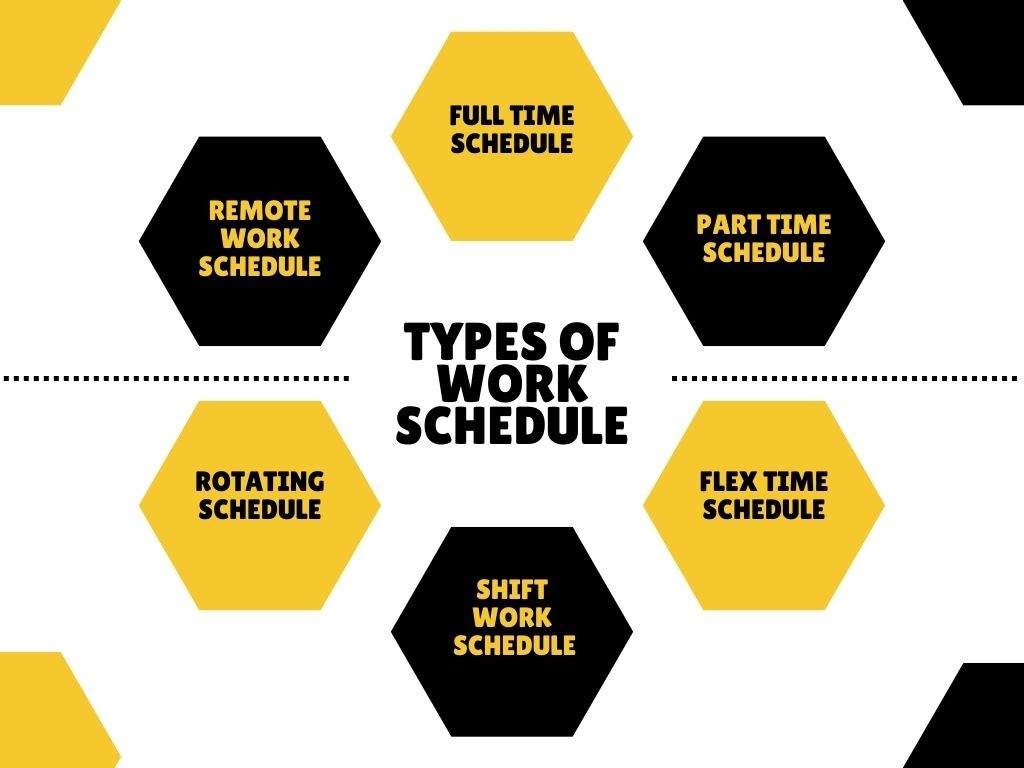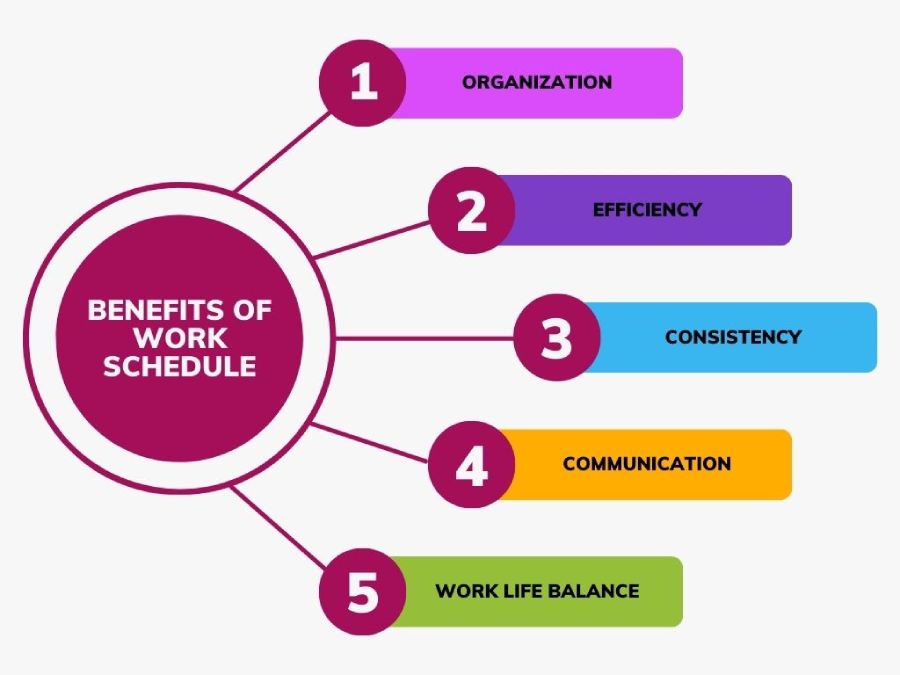Explore efficient work scheduling methods, types, design factors, benefits, and tools for effective management.
What is a Work Schedule?
A work schedule is a plan that specifies the time when the employees are supposed to be at work. It is just like a schedule that indicates the days and the hours people have to work. Work schedules provide employers and employees with a clear understanding of when the work has to be done and when people can have a break from work.
Imagine that your work schedule is a map of your work time. In the same way that you create a to-do list for the day, a work schedule will tell you the tasks you should be working on and when. It is significant because it makes everybody know the time they should be at the office and this makes things done on time.
Work schedules can take different forms. While some people have a fixed schedule, others may have a rotating shift where they will work different shifts on different days. Some of the jobs can be done in the daytime, and some can be in night shifts. However, the schedule may be different, but the goal remains the same, work should be done and employees should have a good balance between work and leisure time.
What are the common types of work schedules?
Following are some common types of work schedules.

Full-Time Schedule:
Full-time schedules usually mean working up to 40 hours per week, which is from Monday to Friday, with fixed hours every day. Employees are on this schedule on a routine basis, giving most of their time to their work. They typically have regular hours and predictable duties throughout the week.
Part-Time Schedule:
Part-time schedule is defined as working less than 30 hours per week, which is less than full time. Working hours of part-time workers can be cut down and they may be assigned to work fewer shifts or fewer days per week. It allows people who are unable to do full-time jobs because of other personal commitments, jobs or lifestyle choices.
Flex Time Schedule:
The flex time schedule will allow the employees to choose the working hours within the time frame set by the employer. A key shift is where the workers must be physically present, but they can come in at different times as long as they finish their working hours within a given time frame. This is the chance for the employees to have a better work-life balance.
Shift Work Schedule:
Employees are required to work in shifts, covering all hours of the day, for the whole week. This is the case in sectors such as healthcare, manufacturing and customer service where timing is everything. Employees can work on a shift basis during the day, evening or night, changing the shifts according to the planned schedule.
Rotating Schedule:
In the case of rotating schedules, workers work rotationally on different shifts. Such as they might work mornings one week, evenings the next, and nights the following week. This type of schedule would enable employees to work in shifts and it would be a way to very effective prevent burnout by changing work hours and tasks.
Remote Work Schedule:
Remote working schedules provide an opportunity to work outside the office environment, for instance, at home or in co-working spaces. They manage their schedule and tasks using digital tools and communication software that can be accessed online. Remote work schedules give more flexibility and freedom to the workers, allowing them to work whenever and wherever possible, as long as they meet their job requirements and complete their assigned tasks.
What Factors Should be Considered When Designing a Work Schedule?
The following are the factors that should be considered when designing a work schedule.
Availability of Employees:
Consider the availability of your employees when creating the schedule. Consider their preferred work hours, any personal obligations, and their ability to work specific shifts or days.
Workload and Tasks:
Determine the workload and the tasks that need to be done and distribute them equally across the work schedule. Make sure that employees have enough time to finish their work without being stressed.
Business Needs:
Think about the operational needs of the business, like peak hours or times when specific tasks must be completed. Create the schedule in such a way that there is enough coverage during these times.
Legal Requirements:
Provide a work schedule that is in compliance with the labour laws and regulations on maximum working hours, overtime pay and rest hours. Know the legal requirements that are specific to your industry or area.
Communication and Feedback:
Include employees in the scheduling process by inviting their views and suggestions. Give the schedule in advance for better understanding and be open to making changes in timings based on employees’ needs and preferences.
Shift Rotation:
When you’re on a shift work then think about a rotation of schedule. By doing it this way, the employer ensures everyone has an equal opportunity to work a different shift fairly. Adopting this strategy will prevent employees from being overworked and make sure that everyone can have a turn in different shifts.
Flexibility:
The schedule should be made as flexible as possible to be able to deal with any unexpected events or emergencies. Undertake the execution of policies or procedures concerning time off requests or shift swaps to implement a smooth running.
Technology and Tools:
Take advantage of scheduling software or tools to make the scheduling process simpler and thus more accurate. Through the utilization of these tools, you will be able to easily optimize employee shifts, preferences as well as availability management.
Employee Well Being:
Employee well-being should be the first thing you consider when making a schedule. Do not use shifts involved in long term fatigue or stress. Make the work schedule to generate a work-life balance that boosts the employees’ satisfaction.
What are the Benefits of having a Structured Work Schedule?
Below are the benefits of having a structured work schedule.

-
Organization:
The structured work schedule enables and facilitates the organization and arrangement of everything. It suggests when employees are supposed to be working, what things they must do and how often they can take a break.
-
Efficiency:
The structured schedule allows employees to know exactly what they need to do and when. This helps them manage their work more efficiently, reducing time spent on unnecessary things and increasing their productivity.
-
Consistency:
Having a structured employee work schedule is helpful for the employees as it allows them to organize their lives around their work. Another one of its advantages is that it develops a sense of regularity, thus benefiting job satisfaction and decreasing stress.
-
Communication:
A structured work schedule makes it simple for employees and managers to talk to each other. It gives them a shared starting point for talking about things like what is expected at work when people are available, and if any changes need to be made.
-
Work Life Balance:
By clearly specifying work hours and expectations, a well-structured their work responsibilities and personal lives. This leads to job satisfaction and overall well-being.
What Tools and Software are Available for Managing Work Schedules?
Following are the tools and software that are available for managing work schedules. Here are some commonly used ones:
Employee Scheduling Applications:
Scheduling applications make it possible for employers to develop work schedules and manage them online. It usually consists of a pick and place scheduling interface, employee availability monitoring with shift exchange capabilities and more.
Time Tracking and Attendance Systems:
The time and attendance systems help in monitoring the employee working hours and attendance. These may involve clocking in and out, timesheet management, and reporting, among others to track employee attendance and on time performance. Some of the advanced time tracking tools offer scheduling features.
Calendar Management Tools:
With the assistance of a calendar application such as Google Calendar or Microsoft Outlook, work schedules can be constructed and distributed among the employees. They have functions like repeating events, reminders, and color-coding which help to maintain a balance in the schedule.
Comprehensive Workforce Management Solutions:
Workforce management software refers to a tool that may be used for managing scheduled work, work-shifts, and reports. These things might be able to do things like forecasting, compliance monitoring, and labour cost management all of which are necessary to make sure that employees are conducted appropriately.
Team Communication Platforms:
Communication apps like Microsoft Teams can be used to send updates on employee schedules and even discuss schedule changes or shift transferring between employees. They provide you with the opportunity to exchange information right away, to send and receive files and to collaborate in real-time.
Time Champ: A Comprehensive Time Tracking and Work Scheduling Software
Time Champ is a user-friendly employee time tracking and management tool that facilitates the process of creating and managing work schedules. Using Time Champ, managers will be able to schedule who works when and everyone will be aware of their schedule. It’s like having a virtual assistant that takes care of all those scheduling details hence the managers can forget about it.
Next, Time Champ notifies employees about their upcoming shifts, to ensure they never forget their working hours. This makes everyone follow the schedule and there is less possibility of someone missing their shift. Generally, Time Champ makes it easier to prepare and manage schedules, which is a positive feature for businesses of any size.
Following are the features of Time Champ, these can make the process of creating and managing work schedules much simpler.
Scheduling Efficiency:
The user-friendly interface of Time Champ simplifies the process of work schedule making and managing, which saves managers time and effort needed for scheduling tasks.
Automated Remainders:
Time Champ helps managers set up automatic notifications to staff reminding them of their shift, thus avoiding the occurrence of missed shifts or late coming.
Time Tracking:
Time Champ can perfectly calculate the amount of time spent by employees at work, offering instant data for management on schedules and overtime, and letting managers prevent unauthorized overtime and comply with labour regulations.
Ready to streamline your scheduling process? Try Time Champ today and experience the difference in managing your work schedule!
Optimize work schedules and enhance your team's productivity with ease
Boost your productivity with Time Champ's optimized work schedules!
SignUp for FreeBook DemoConclusion
Work schedule is one of the most important aspects of organizational success, employee motivation and satisfaction, as well as personal and family life. Therefore, understanding different types of schedules, the availability of employees, business needs, the legal framework, and the use of the scheduling tools are crucial for increasing productivity and communication within a business. In conclusion, work scheduling is one of the essential tasks in business that enables achievement of the organizational goals alongside the promotion of workers’ health.
Frequently Asked Questions
Work schedule is a plan that shows when the employees are expected to work. It usually covers the deployment schedule, days off, and any other scheduling considerations.
Work schedules are important for various reasons. They assist businesses in scheduling proper coverage, ease the communication between employees and managers and set routines and predictable working hours for both employees and managers.
The most common types of work schedules are full-time work schedules, part-time work schedules, flex-time schedules, shift work schedules, rotating work schedules and remote working schedules.
An effective work schedule should be based on factors like the availability of workers, workload and tasks, business needs, employees’ preferences, legal regulations, shift rotation, and communication methods.
There are different kinds of tools and software available for managing work schedules, including scheduling software, calendar apps, time and attendance systems, employee scheduling apps, communication platforms, and workforce management software.







